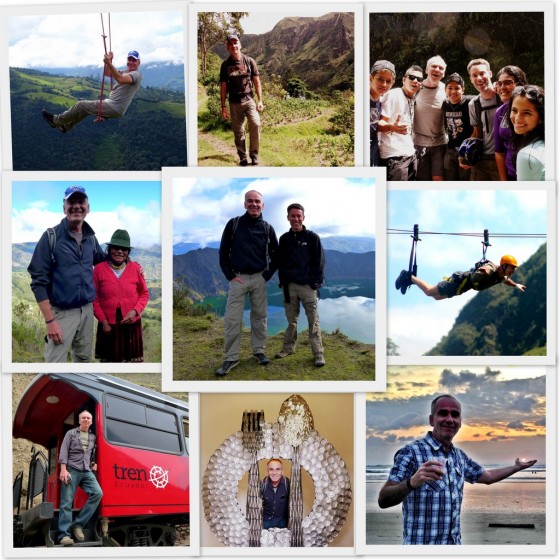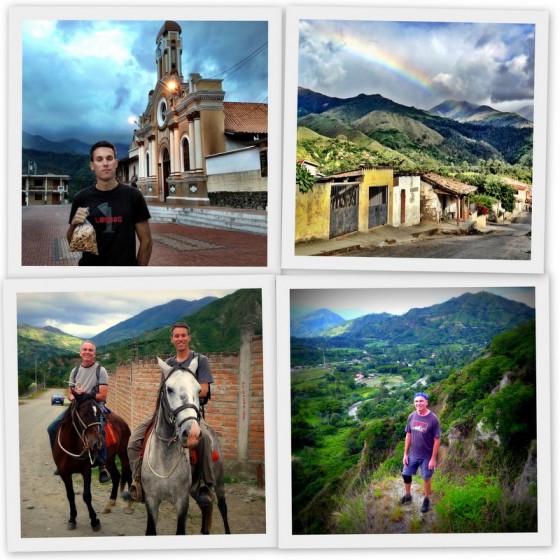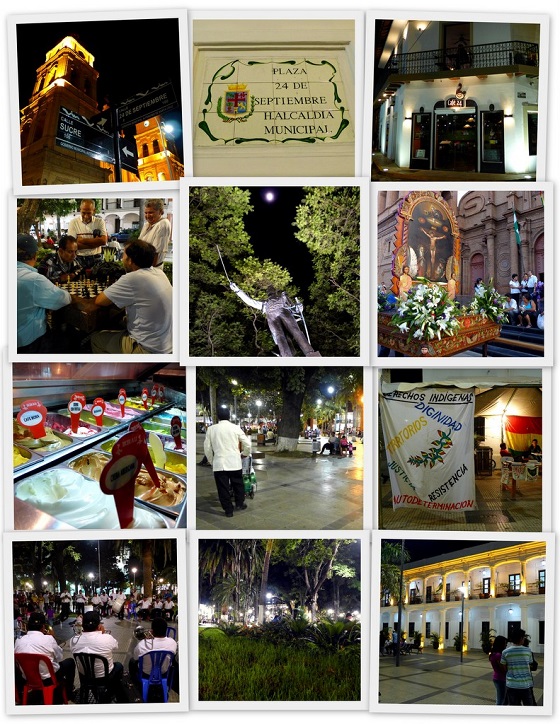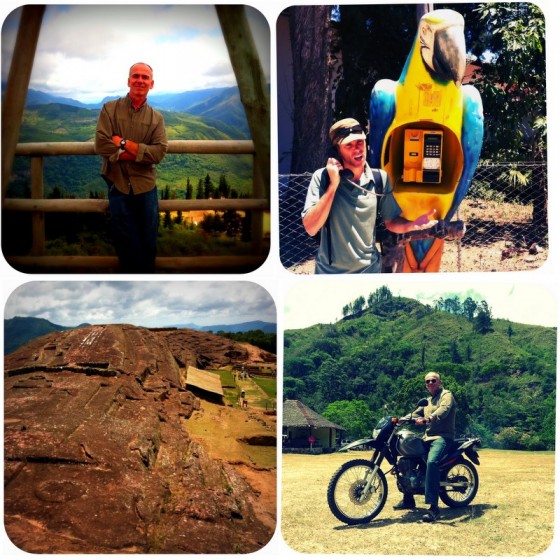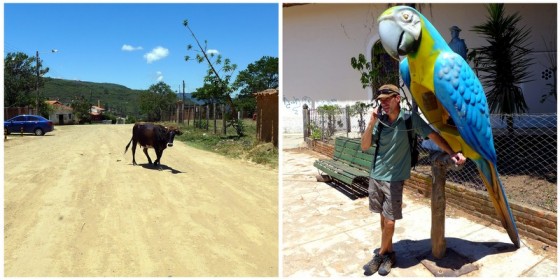You must be logged in to view this content.
Tag: Paul
Peter’s Picture Show: Tirolesas en las Barrancas del Cobre
Here’s Paul and I flying high on the ziplines at the Adventure Park from the rim of the Barrancas del Cobre (Copper Canyon) in northern Mexico’s Chihuahua state. Comprising seven adjacent canyons, this area is estimated to be many times larger and at least twice as deep than the Grand Canyon in Arizona.
It’s a majestic and scenic area rich in greenery which resembles oxidized copper, hence its name. The indigenous Tarahumara inhabit the cliffs and valleys and continue to practice a traditional nomadic lifestyle. They are still a visible feature of the entire region. Refreshingly little visited by tourists, Mexico’s Copper Canyon is a traveler’s delight with endless opportunities for hiking, mountain biking, horseback riding and exploring picturesque pueblos mágicos.
And if the Adventure Park’s seven ziplines, two rocky suspension bridges, and a 2-mile long gondola ride back to the rim aren’t enough to get your adrenaline rushing, in a couple of weeks the park will inaugurate the longest zipline in the world: a thrilling 8,350 foot (1.5 mile) drop from the canyon rim. We’ll surely be back for that.
Peter and Paul’s Numero Unos of Ecuador
There was so much we loved during our weeks in Ecuador but here are the standout “Number Ones” from each of us:
Paul’s #1 Thrill

Riding the “milk truck” on a journey that seemed to climb its way to the apex of a very remote and stunning area of the Andes. We enjoyed the open air with the camaraderie of the locals who, like us, were taking the only ride out of town that day. The only thing missing was a thermos of nice hot coffee because we did have the luxury of an endless supply of fresh creamer right at our fingertips.
Peter’s #1 Natural Wonder
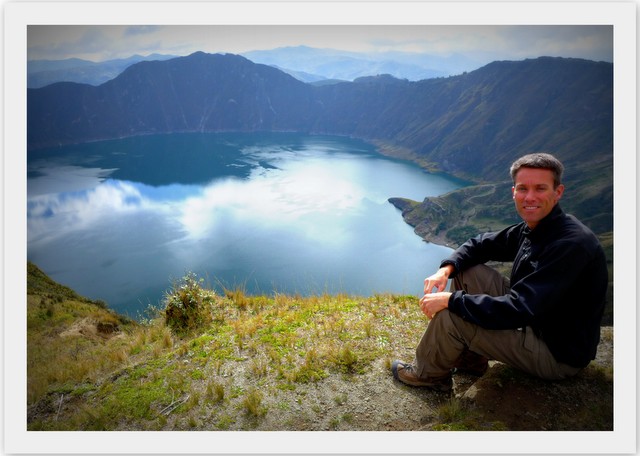
The captivating Quilotoa Crater Lake was a supremely blissful start of our 3-day trek through the remote Andean highlands. Every step of our walk was beautiful but the splendor of Volcán Quilotoa’s turquoise water was the most dazzling of all.
Paul’s #1 People
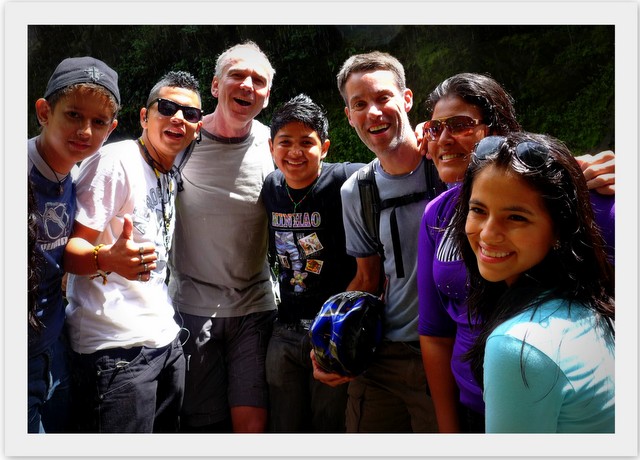
The group of young Ecuadorian hikers we met at the waterfall near Baños. If they are an example of the young and upcoming generation in Ecuador I have great hope for that country. I was thoroughly impressed with their enthusiasm, curiosity and manners not to mention they were just plain fun.
Peter’s #1 Animal
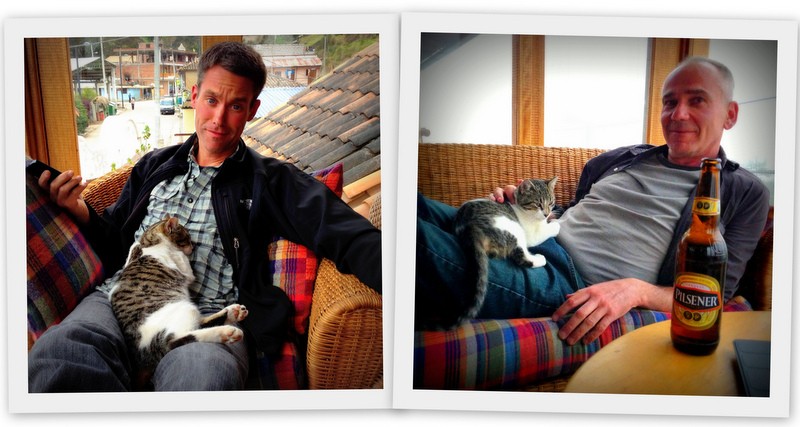
We encountered countless friendly critters in Ecuador, but none endeared our hearts like Felipe in at our hostal in Chugchilán. This lovely little cat spent every moment with us: purring on our laps, rambunctiously playing with peacock feathers, knocking over beer bottles, sneaking in the dining room to sniff our food, and generally being an entertaining nuisance. Oddly the owner said Felipe was in “mourning” over the recent death of his sister, but to us Felipe was always in the highest of spirits – he certainly lifted ours.
Paul’s #1 Area
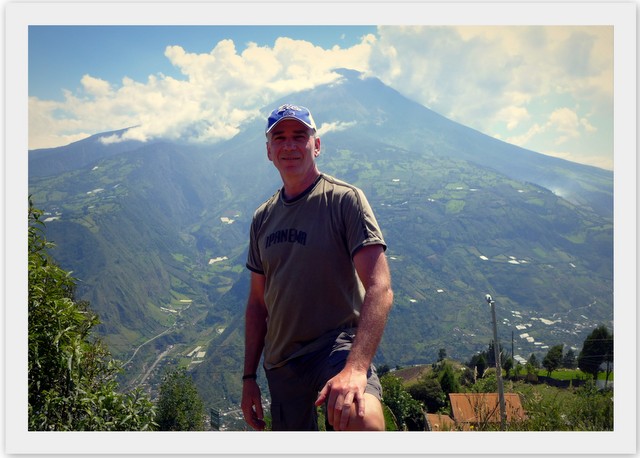
Baños. I not only enjoyed the immense beauty of the stunning scenery which engulfed this town but the energy that seemed to permeate every nook and cranny was infectious. The town was filled with backpackers who seemed to be on a single quest… to challenge themselves with a myriad of activities ranging from zip lining to bungee jumping and every other hair-raising experience in between. Oh… did I mention the daily soak in the natural hot springs which was just icing on the cake in this little paradise of the Andes.
Peter’s #1 Show
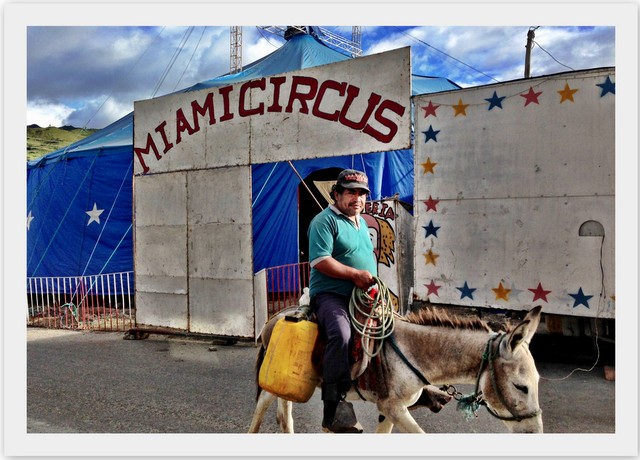
Barnum & Bailey’s it wasn’t but the traveling Miami Circus’ small troupe of performers that landed in Vilcabamba far surpassed our expectations. The clowns had us laughing hard while the charmingly hokey trapeze acts kept us in our seats – unexpected feats for a pint-sized Big Top!
Paul’s #1 Hostel
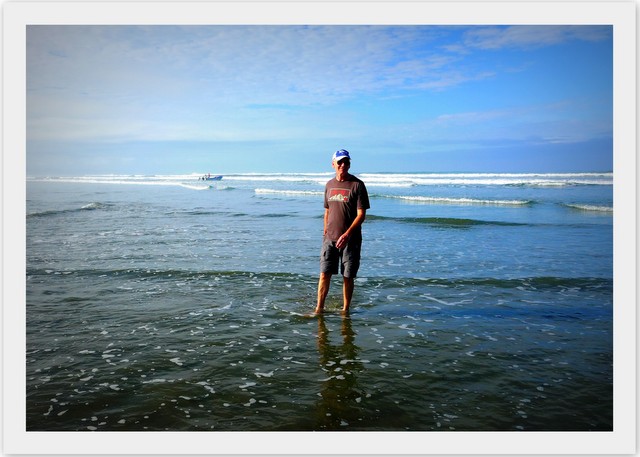
The beach shack in Canoa which was akin to popping several Valiums every day. I have never known such deep relaxation in the week we had the pleasure of staying there. I’m not sure if it was the fact we were barefoot the entire week…or could it be the gentle sway of the hammocks which we seemed to live in….or maybe the mellow rhythm of the surf… how about the cool and constant ocean breeze which kept us so wonderfully comfortable? It was all just perfect.
Peter’s #1 Meal
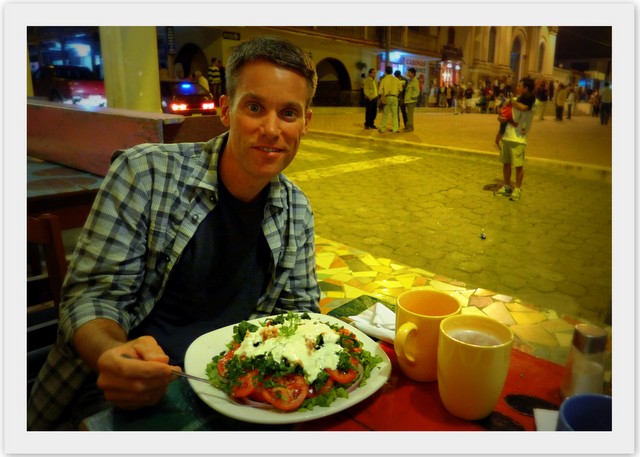
Weary after a couple weeks of dining on heaps of rice and heavy fried plantains, we keenly ordered up two salads in Vilcabamba that were delightfully satiating. With crisp, crunchy greens from the surrounding fertile valley and delicious home-made salad dressing, it was a pleasingly healthy and hearty meal. And despite the nationwide Sunday ban on alcohol, the waiter was gracious enough to surreptitiously serve us beer in coffee mugs – ah, the recalcitrance of small towns!
Paul’s #1 Drink
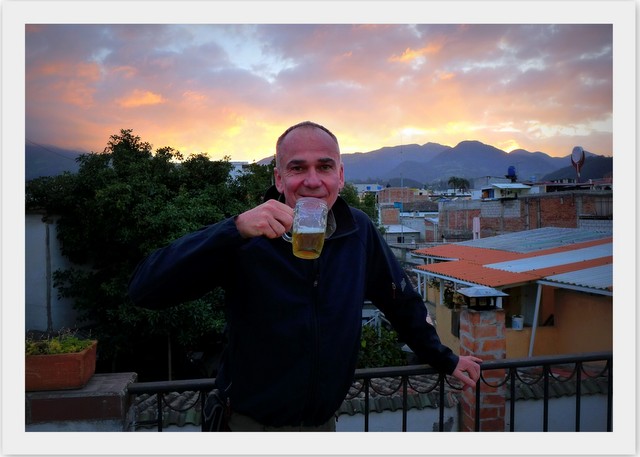
My Club Rojas beer. I can’t think of a better way to spend a dollar on a warm and sunny afternoon.
Peter’s #1 Non-alcoholic Beverage
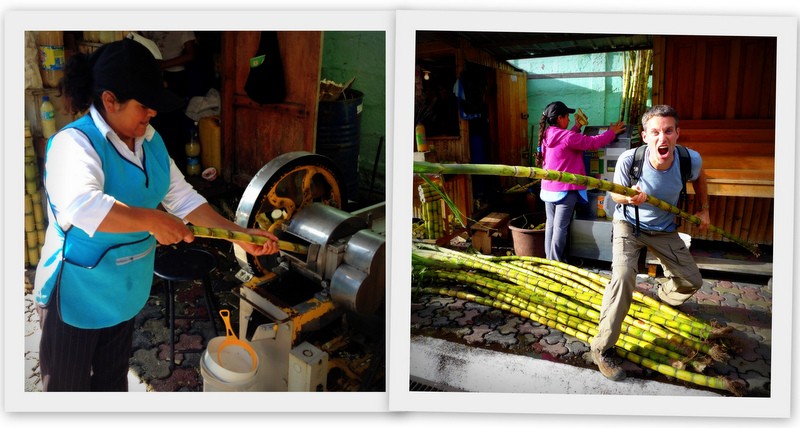
We loved the fresh-pressed sugarcane juice found everywhere in Ecuador. Street vendors cranked the tough stalks through clanking presses that squeezed out fresh yellowy guarapo. After our active days in Baños, the sweet glasses of jugo de caña never failed to replenish our energy.
Paul’s #1 Scariest Moment
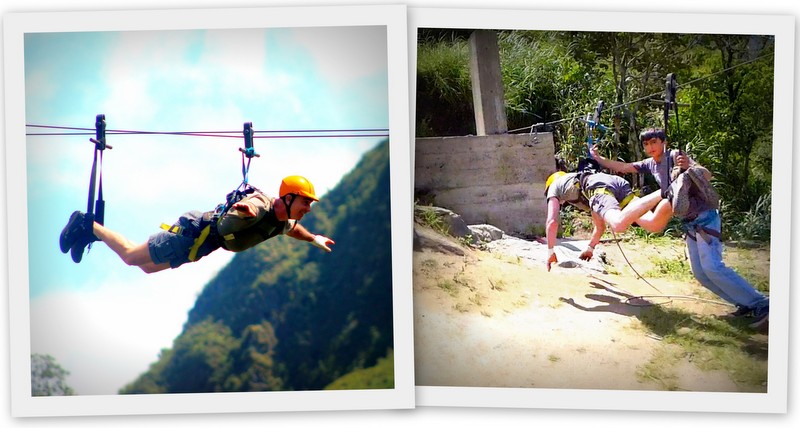
Coming inches away from cracking my head on a concrete wall at the end of the zip line ride. Going from 40km per hour to 0 head first just a few feet from this wall gives me a headache just thinking about it.
Peter’s #1 Ride

Our Ecuadorian train journey up and down the sheer 600 m (2,000 ft) cliffs of Nariz del Diablo in the Andes was a pure thrill. We were mildly disappointed when we learned we could no longer ride on top of the carriage (two Japanese tourists fell off and died), but the panoramic windows provided sufficiently knuckle-biting views.
Paul’s #1 Exciting Moment
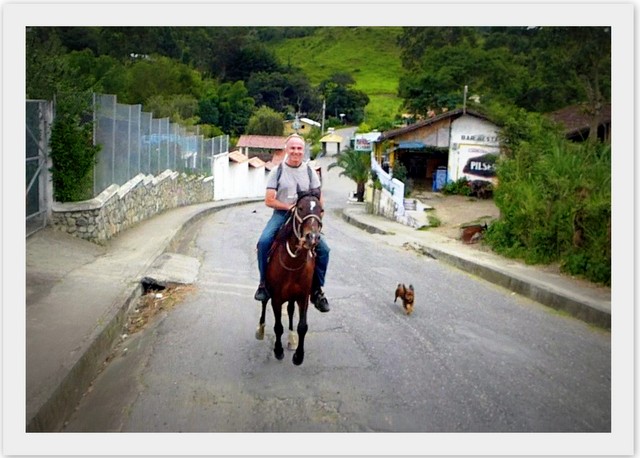
Galloping down Main Street in Vilcabamba on a horse named Tequila. It would have made John Wayne very proud.
Peter’s #1 Rainfall

Passing through Mindo, the birding capital of Ecuador, we decided to take a waterfall walk through the rainforest. And it rained and rained and rained. It is the rainforest after all… ‘nuff said.
Paul’s #1 View
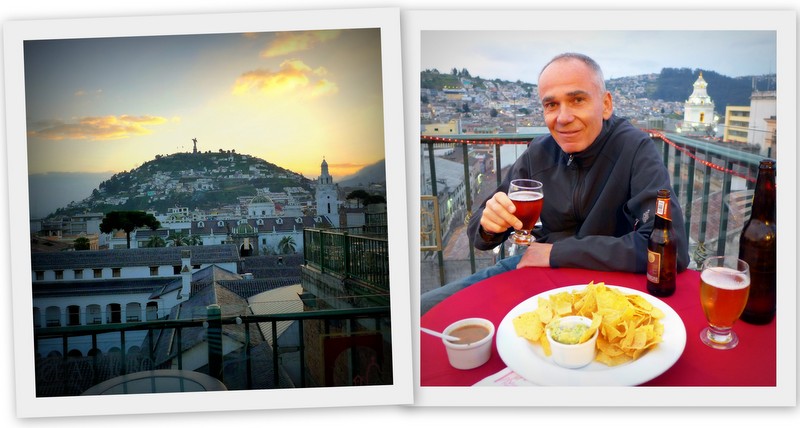
From the rooftop bar in Quito’s Old Town.
Peter’s #1 High
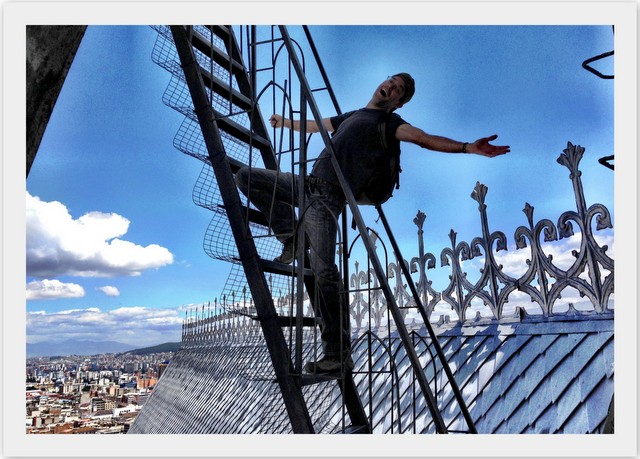
The Basílica del Voto Nacional in Quito offers intrepid travelers a chance to scale the soaring bell towers for blessed views of the city and area volcanoes. Paul said I look like a Broadway actor wannabe in this photo… it would make a great setting for a Cats-inspired musical: Bats! (In The Belfry)
Beach Bums: A Week in Coastal Canoa
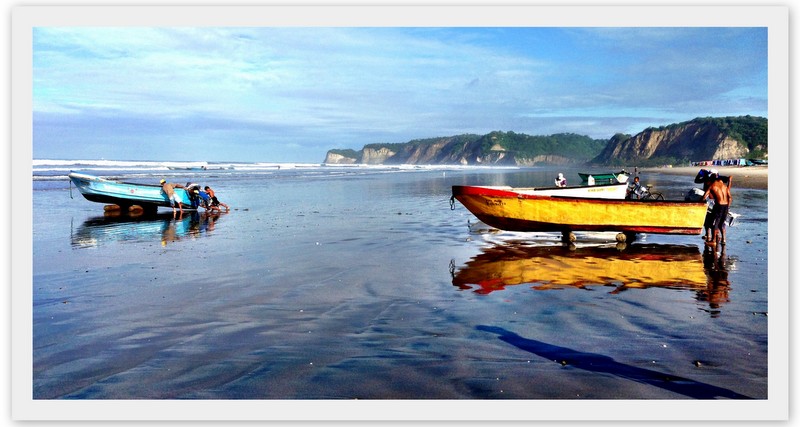
There’s not a lot to report from the Pacific Coast of Ecuador – we spent an uneventful week relaxing with our feet plunked in the sand, swinging in a hammock under palm trees, drinking cold beers and eating fresh catch seafood with piles of rice and fried plantains.
After months of being at altitude high in the dry Andes of Bolivia and Peru, I was craving water. Specifically the ocean. My home for the past decade has been coastal Maine and the sea has become a constant in my life. I was drained from my service as a Kiva Fellow crisscrossing Bolivia and Paul was ready for a break from the airlines.
It was time for some beach R&R.
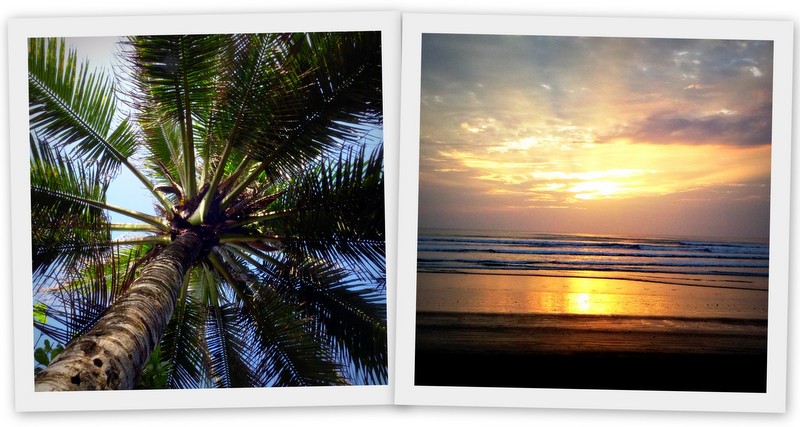
Canoa was recommended to us by several travelers – it’s small enough to duck the surf-and-party scene yet large enough to offer good backpacker accommodation and an assortment of mom-and-pop restaurants. And with surfable waves and undeveloped beaches that stretch for miles, Canoa was our pick and we quickly settled into our comfy beachfront bungalow at the Hostal Baloo.
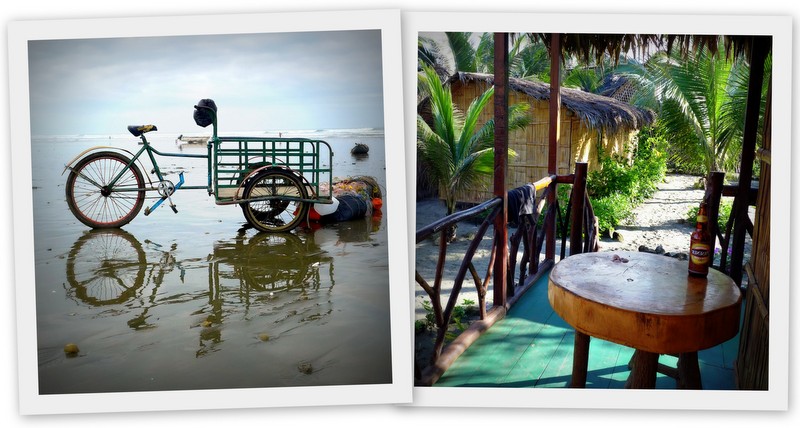
Our days pretty much went like this:
Continue reading “Beach Bums: A Week in Coastal Canoa”Ecuadorian Excursion: The Quilotoa Loop
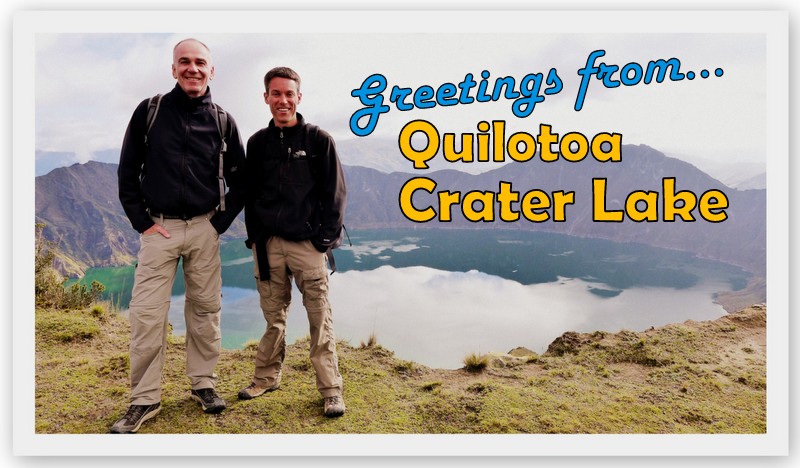
Flipping through the pages of Lonely Planet Ecuador we found a short segment on the Quilotoa Loop, a walking circuit in the central Andean highlands. Eager to leave the tourist-heavy main corridor of the Panamericana highway, this was right up our alley. Offering energetic walks through attractive valleys and nights in isolated Kichwa-speaking villages, this outdoor Ecuadorian excursion reminded us of our gratifying rambles in the UK and Ireland.
So we dumped our heavy stuff in storage at our friendly hostal in Latacunga and set off with light backpacks on a bus bound to Zumbahua. There we found a large crowd awaiting the appearance of Rafael Correa, the socialist president campaigning for his third term.
He’s wildly popular among Ecuador’s indigenous voters: he learned Kichwa (the dominant local language) and has systematically backed strong social programs and public works since he took office in 2007. Fortunately there are sufficient funds to implement these changes since the new constitution guarantees that 85% of proceeds from Ecuadorian resources stay in the country (rather than 15% previously) – much to the chagrin of large multinational companies.
Correa is part of a growing group of popular and pragmatic leftist leaders taking root in Latin America in the last decade, known as the Pink Tide, which rejects the “Washington consensus” policies of unchecked open markets and rampant privatization. Widely expected to win by a landslide, Correa is already the longest-serving Ecuadorian president in more than a century. The current political and economic stability offers enormous hope and optimism for a large part of previously disenfranchised Ecuadorians.
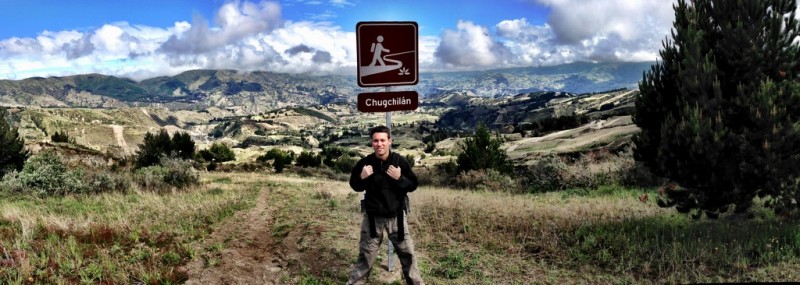
Our first stop was in Quilotoa, a settlement on the rim of Volcán Quilotoa with its stunning turquoise crater lake. We spent the night with other walkers from Germany, Australia, the United Kingdom and Brazil, sharing a hearty family-style meal. We love these kinds of hostales where meeting fellow travelers is easy and conversations flow breezily. It was chilly on the rim at nearly 4000 m (13,000 ft) but the camaraderie warmed our hearts.
Greeted with sunshine the next morning, we explored the lake and walked along the rim towards Chugchilán. All the small villages along the route have somewhat tongue-tricky names (such as Isinliví and Saquisilí) so we found it easier to refer to them by first letter (i.e. “I-town” and “S-town”).
Continue reading “Ecuadorian Excursion: The Quilotoa Loop”Baños: Getting Wet and Wild in Ecuador’s Outdoor Paradise
What fun we had in Baños! I was somehow expecting this given that pretty much everyone we met had told us so. “It’s touristy,” they all warned us, “but you’ll barely notice it once you start doing stuff.”
Normally when my expectations are high about a place I tend to be underwhelmed when I get there. But in the case of Baños, I can honestly say it was more pleasing than I anticipated.
Baños is touristy. So much so that there are literally hundreds of hotels and restaurants in the relatively small town of 10,000 residents. But this also means that competition among businesses is intense so the quality is high and the prices very favorable to the tourist.
Our hotel, for example, Hostel La Chimenea was a delight: sparkling clean and spacious rooms with private bathrooms and balconies, a pool and sauna, wireless internet, a rooftop terrace with views of the surrounding mountains and waterfalls, a great breakfast restaurant, and friendly laid-back management. All this for a mere $8.50 a person!
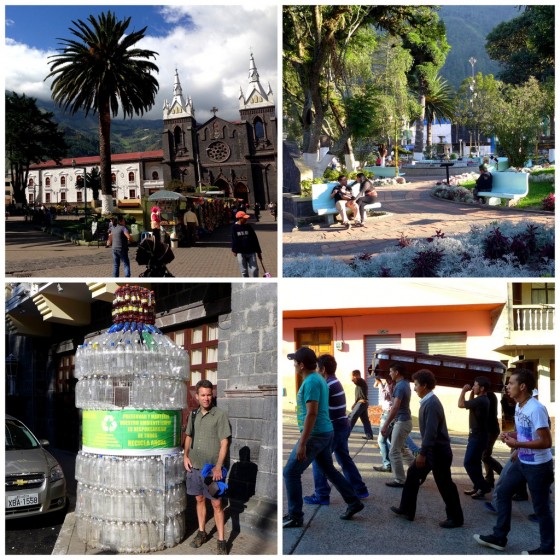
The real charm of Baños is not the town but the surrounding area. There are miles of excellent hiking trails with views of the active Tungurahua volcano which towers above the valley at 5,023 m (16,480 ft). There is mountain biking past scores of waterfalls, mostly down hill with frequent buses to whisk you (and your wheels) back effortlessly to Baños. You can whitewater raft, bungee jump, zipline, rappel down waterfalls and rent ATV’s. And since the mountains descend rapidly to the eastern Amazon, you can even tour tropical indigenous areas and spot jungle wildlife.
After all this adventuring, you can relax in the numerous hot mineral springs in Baños (known officially as Baños de Agua Santa or “The Baths of Sacred Water”). Our favorite were the baths just two blocks from our hotel which sit beneath a striking 100 m waterfall. We went every day, sometimes during the mornings when we encountered quiet older Ecuadorians, and a couple times during the evening when it is packed with locals and travelers – the happening social scene in town.
Clearly there is much to love about Baños. Here are some of the many things we enjoyed during our visit:
Fantastic Food

Continue reading “Baños: Getting Wet and Wild in Ecuador’s Outdoor Paradise”
Home Is Wherever I’m With You…
Well… another arrival and departure of Paul. It doesn’t get easier.
We had an extraordinary five weeks together in Ecuador’s wild playground: traipsing through the rainforest, flying on zip-lines above thundering waterfalls, crisscrossing the Equator, hiking past volcanoes, descending the steepest railroad track in the world, lounging on Pacific Coast beaches, galloping through the tropics on horseback, mountain biking from the Andes to the Amazon — we did it all.
It’s been a transient few months for us. I’ve been living in South America, volunteering and traveling through four countries. Paul has been moving between friends and family and joining me when he can. We have no fixed address since we rented our home.
But we’re not homeless. We’ve long yearned to be free of the hassles and headaches of maintaining a house and being tied down. It has been a long (and arduous) process of letting go.
We’re working to establish a new way of living, one that is freeing but also fleeting. The bonds of living together under one roof become slippery; special care is required to keep our relationship on meaningful footing.
This is new to us. It’s exciting, tricky, bold, and irregular… We’re learning as we craft new ways to engage our interests and passions and each other.
Today as I entered Colombia I was marveling (as usual) at the breathtakingly awesome Andes. And reflecting on my rambling ’round life — now in its fifth month.
The truth is I deeply miss Paul. But I’m also very happy. It puzzles me.
Then as this song popped in my headset the light bulb went off:
Ahh, Home
Let me come Home
Home is wherever I’m with you
Ahh, Home
Let me come Home
Home is whenever I’m with you
This feels crazy but it all makes sense.
Home by Edward Sharpe & The Magnetic Zeros:
Vilcabamba: Land of Longevity
We rushed to escape the clouds and cold of Cuenca, traveling about six hours south to the small town of Vilcabamba. Nestled in the green hills near the Peruvian border, Vilcabamba has attracted a fair number of expatriates who appreciate the laid-back feel, the mild climate, the relative isolation and its attractive natural setting.
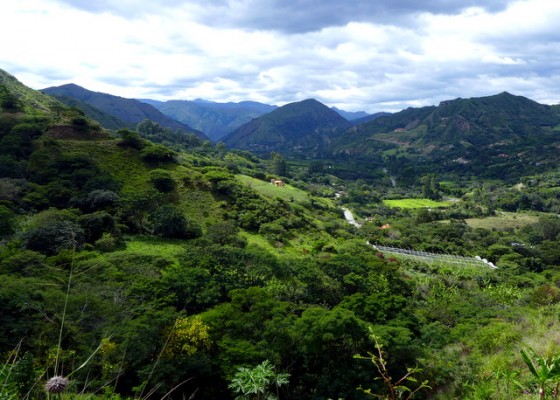
Paul and I immediately took to the town. We settled into our cozy hostal just a block off the main square, replete with a hammock on the balcony and lush gardens inside the expansive walled patio. We chatted with the caretakers, an English-Romanian couple who own a well-regarded restaurant in Cuenca and agreed to run the hotel in Vilcabamba while their friend/hotelier takes a much-needed sabbatical.
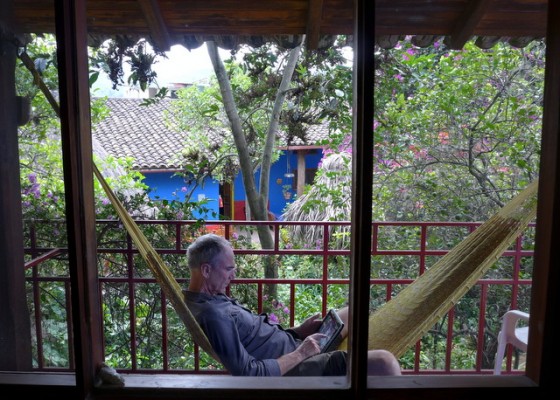
Vilcabamba has a great feel. It attracts a trickle of backpackers and the expat residents are mostly alternative/hippy types who seem to integrate well with the locals. We met young and old, and many families live here. It’s not uncommon to see bilingual European or North American kids playing in the main square with their Ecuadorian friends.
Plaza 24 de Septiembre: The Heart and Soul of Santa Cruz
The plaza principal in Latin America is an amalgam of the social, cultural, religious and political life of latinos. Here is where you find it all: protests and politics, seasoned romance and youthful exuberance, food and festivals, lush foliage and (occasionally) flowing fountains, majestic churches, music and laughter, promenading locals encircling comedians, Bible thumpers and magicians. The plaza reflects the people.
I wander the main Plaza 24 de Septiembre in sultry Santa Cruz de la Sierra in eastern Bolivia, so-named to honor the auspicious day in 1810 when the city joined the Buenos Aires junta rising against Spanish colonial rule.
On this night surrounded by the crowds and energy of the plaza, I find myself alone but not lonely. Paul left this morning after three marvelously companionable weeks crossing the country. This is the picture I see around me, a whirling world of sights and sounds and smells.
Continue reading “Plaza 24 de Septiembre: The Heart and Soul of Santa Cruz”
Finding R&R (Rest & Ruins) in Serene Samaipata
In Quechua the town means “The Height to Rest” – and indeed this is where Paul and I found a relaxing and picturesque place to kick back for a long weekend. We were coming from steamy, tropical Santa Cruz in the eastern lowlands of Bolivia in search of cooler temperatures and an escape from the crowds. It was our last weekend together in Bolivia before Paul had to return home.
Samaipata is something of an anomaly for Bolivia. Blessed with a delightful subtropical climate and tucked in the easternmost folds of the Andes mountains, the area has attracted foreigners for centuries: first the Sephardic Jews expelled from peninsular Spain during the Inquisition, later some Italians and Croats, and finally a sizable number of expats (mainly artists and free-thinkers from Europe) starting in the 1970’s when the road from Santa Cruz was paved.
Perhaps the most celebrated foreigner to come to the region was Ernesto “Che” Guevara in 1966 during his ill-fated attempt to bring Socialist revolution to South America. He was killed almost a year later in the nearby village of La Higuera.
Today Samaipata remains a sleepy backwater with quiet colonial streets, a peaceful Plaza Principal filled in the evenings with locals on promenade and traveling hippies playing music and selling hand-made wares. The resident expats are barely visible but present, often running businesses catering to tourists. Samaipata hosts organic farms, Buddhist meditation retreats, ecological construction (my superadobe instructor from La Paz is based here), and a large number of reveling cruzeños from Santa Cruz on holiday weekends.
Samaipata is an especially agreeable place. It reminded us of what San Miguel de Allende in Mexico may have been like decades ago.
Continue reading “Finding R&R (Rest & Ruins) in Serene Samaipata”

